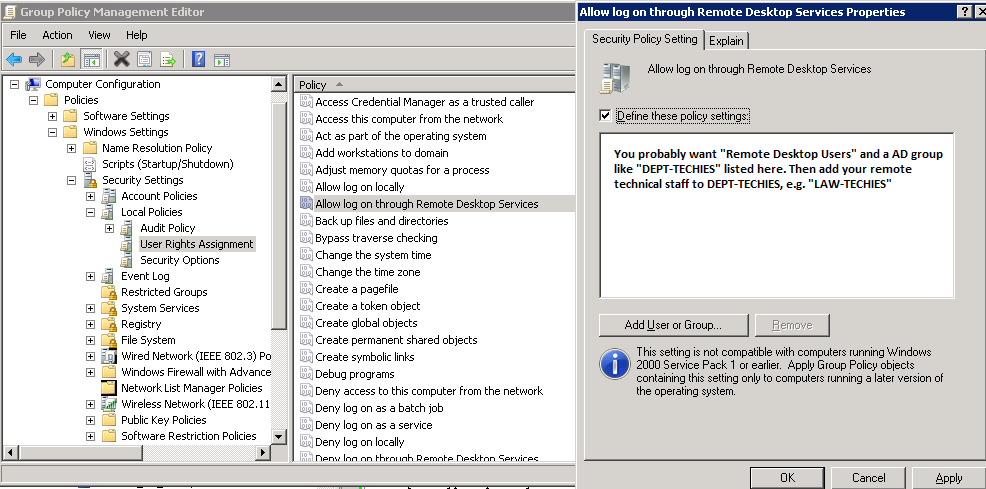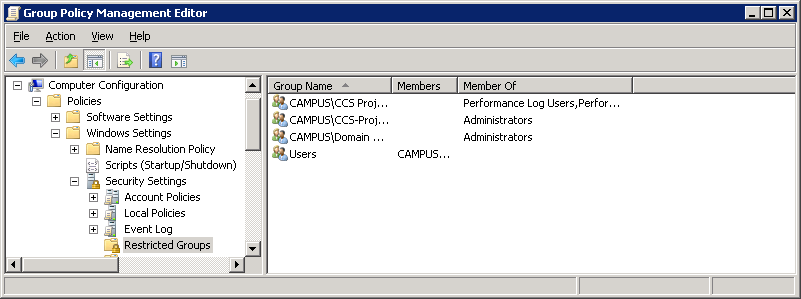Remote Desktop sessions operate over an encrypted channel, preventing anyone from viewing your session by listening on the network. However, there is a vulnerability in the method used to encrypt sessions in earlier versions of RDP. This vulnerability can allow unauthorized access to your session using a man-in-the-middle attack. Remote Desktop can be secured using SSL/TLS in Windows Vista, Windows 7, and Windows Server 2003/2008.
While Remote Desktop is more secure than remote administration tools such as VNC that do not encrypt the entire session, any time Administrator access to a system is granted remotely there are risks. The following tips will help to secure Remote Desktop access to both desktops and server that you support.
Basic Security Tips for Remote Desktop
Use strong passwords
Use a strong password on any accounts with access to Remote Desktop. This should be considered a required step before enabling Remote Desktop. Refer to the campus password complexity guidelines for tips.
Update your software
On advantage of using Remote Desktop rather than 3rd party remote admin tools is that components are automatically updated to the latest security fixes in the standard Microsoft patch cycle. Make sure your are running the latest versions of both the client and server software by enabling and auditing automatic Microsoft Updates. If you are using Remote Desktop clients on other platforms, make sure they are still supported and that you have the latest versions. Older versions may not support high encryption and may have other security flaws.
Restrict access using firewalls
Use firewalls (both software and hardware where available) to restrict access to remote desktop listening ports (default is TCP 3389). Using an RDP Gateway is highly recommended for restricting RDP access to desktops and servers (see discussion below). As an alternative to support off-campus connectivity, you can use the campus VPN software to get a campus IP address, and add the campus VPN network address pool to your RDP firewall exception rule. Seehttp://net.berkeley.edu/vpn/ for more information on the campus VPN service.
Enable Network Level Authentication
Windows Vista, Windows 7, and Windows Server 2008 also provide Network Level Authentication (NLA) by default. It is best to leave this in place, as NLA provides an extra level of authentication before a connection is established. You should only configure Remote Desktop servers to allow connections without NLA if you use Remote Desktop clients on other platforms that don't support it. To enable NLA for Windows XP SP3 clients, seehttp://support.microsoft.com/kb/951608.
Limit users who can log in using Remote Desktop
By default, all Administrators can log in to Remote Desktop. If you have multiple Administrator accounts on your computer, you should limit remote access only to those accounts that need it. If Remote Desktop is not used for system administration, remove all administrative access via RDP and only allow user accounts requiring RDP service. For Departments that manage many machines remotely, remove the local Administrator account from RDP access at and add a technical group instead.
A typical MS operating system will have the following setting by default as seen in the Local Security Policy:

The problem is that “Administrators” is here by default, and your “Local Admin” account is in administrators. Although a password convention to avoid identical local admin passwords on the local machine and tightly controlling access to these passwords or conventions is recommended, using a local admin account to work on a machine remotely does not properly log and identify the user using the system. It is best to override the local security policy with a Group Policy Setting.

To control access to the systems even more, using “Restricted Groups” via Group Policy is also helpful.
If you use a “Restricted Group” setting to place your group e.g. “CAMPUS\LAW-TECHIES” into “Administrators” and “Remote Desktop Users”, your techies will still have administrative access remotely, but using the steps above, you have removed the problematic “local administrator account” having RDP access. Going forward, whenever new machines are added in the OU under the GPO, your settings will be correct.

Set an account lockout policy
By setting your computer to lock an account for a period of time after a number of incorrect guesses, you will help prevent hackers from using automated password guessing tools from gaining access to your system (this is known as a "brute-force" attack). To set an account lockout policy:
Best Practices for Additional Security
Change the listening port for Remote Desktop
Changing the listening port will help to "hide" Remote Desktop from hackers who are scanning the network for computers listening on the default Remote Desktop port (TCP 3389). This offers effective protection against the latest RDP worms such, as Morto. To do this, edit the following registry key (WARNING: do not try this unless you are familiar with the Windows Registry and TCP/IP): HKEY_LOCAL_MACHINE\SYSTEM\CurrentControlSet\Control\Terminal Server\WinStations\RDP-Tcp. Change the listening port from 3389 to something else and remember to update any firewall rules with the new port. Although this approach is helpful, it is security by obscurity which is not the most reliable security approach. You should ensure that you are also using other methods to tighten down access as described in this article.
Use RDP Gateways
Using a RDP Gateway is strongly recommended. It provides a way to tightly restrict access to Remote Desktop ports while supporting remote connections through a single "Gateway" server. When using an RD Gateway server, all Remote Desktop services on your desktop and workstations should be restricted to only allow access only from the RD Gateway. The RD Gateway server listens for Remote Desktop requests over HTTPS (port 443), and connects the client to the Remote Desktop service on the target machine.
There are many online documents for configuring this embedded Windows 2008 component. The official documentation is here: http://technet.microsoft.com/en-us/library/dd983949(WS.10).aspx
Installing the configuring the role service is mostly as described; however, using a Calnet issued trusted Comodo certificate is recommended. Using a self-signed cert is ok for testing, and using a CalnetPKI cert can work if all clients have trusted the UCB root. The Comodo cert is usually better accepted so that your end users do not receive certificate warnings.
Some campus units use a IST managed VPS as a RD Gateway, and a VPS seems fine for this purpose. A rough estimate might be that 30-100 concurrent users can use one RD Gateway. The HA at the virtual layer provides enough fault tolerant and reliable access, however a slightly more sophisticated RD gateway implementation can be done with network load balancing.
Configuring your client to use your RD Gateway is simple. The official documentation for the MS Client is here:http://technet.microsoft.com/en-us/library/cc770601.aspx
In essence, a simple change on the advance tab of your RDP client is all that is necessary:

Tunnel Remote Desktop connections through IPSec or SSH
If using an RD Gateway is not feasible, you can add an extra layer of authentication and encryption by tunneling your Remote Desktop sessions through IPSec or SSH. IPSec is built-in to all Windows operating systems since Windows 2000, but use and management is greatly improved in Windows Vista/7/2008 (see: http://technet.microsoft.com/en-us/network/bb531150). If an SSH server is available, you can use SSH tunneling for Remote Desktop connections. Seehttps://kb.berkeley.edu/kb1266 for more information on IPSec and SSH tunneling.
Use existing management tools for RDP logging and configuration
Using other components like VNC or PCAnywhere are not recommended because they may not log in a fashion that is auditable or protected. With RDP, logins are audited to the local security log, and often to the domain controller auditing system. When monitoring local security logs, look for anomalies in RDP sessions such as login attempts from the local Administrator account. RDP also has the benefit of a central management approach via GPO as described above. Whenever possible, use GPOs or other Windows configuration management tools to ensure a consistent and secure RDP configuration across all your servers and desktops.
By enforcing the use of a RDP gateway, you also get a third level of auditing that is easier to read than combing through the domain controller logins, and is separate from the target machine so is not subject to tampering. This type of log can make it much easier to monitor how and when RDP is being used across all the machines in your environment.
Use Two-factor authentication on highly sensitive systems
Departments with sensitive data should also consider using a two-factor authentication approach. That is beyond the scope of this article, but RD Gateways do provide a simple mechanism for controlling authentication via two factor certificate based smartcards. Other two factor approaches need another approach at the Remote Desktop host itself e.g. YubiKey, RSA.
Additional security with Network Access Protection (NAP)
Highly motivated admins can also investigate the use Network Access Protection(NAP) with an RD Gateway, however, that technology and standard is not well developed or reliable yet. Many clients will not work if you enforce it, although by following the documentation, you can audit the system to see if it *thinks* the clients are security compliant

0 comments:
Post a Comment